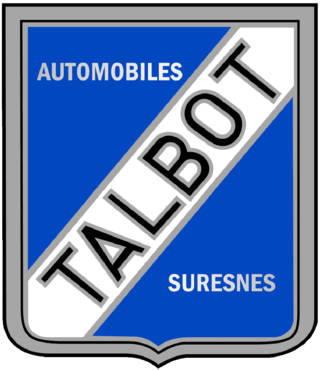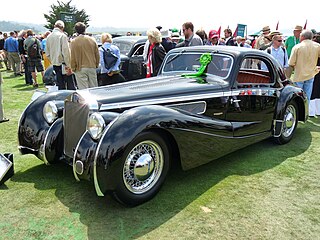
Chappe et Gessalin is the short-form of the name of French coachbuilder "Carrosserie Chappe Frères et Gessalin". The company built automobile bodies and did contract assembly for other automobile manufacturers. It was also the parent of Automobiles CG, a French automobile maker founded in 1966 which built and sold complete cars under its own name.

Talbot-Lago was a French automobile manufacturer based in Suresnes, Hauts de Seine, outside Paris. The company was owned and managed by Antonio Lago, an Italian engineer that acquired rights to the Talbot brand name after the demise of Darracq London's subsidiary Automobiles Talbot France in 1936.

Delage is a French luxury automobile and racecar company founded in 1905 by Louis Delâge in Levallois-Perret near Paris; it was acquired by Delahaye in 1935 and ceased operation in 1953.

The Ferrari 275 is a series of front-engined V12-powered grand touring automobiles with two-seater coupé and spider bodies produced by Ferrari between 1964 and 1968. The first 275 series cars were powered by a 3.3 L (3286 cc) overhead camshaft Colombo 60° V12 engine producing 260–320 hp (190–240 kW). An updated 275 GTB/4 was introduced in 1966, with a revised four overhead camshaft engine producing 300 hp (220 kW). The 275 series were the first road-going Ferraris equipped with a transaxle and independent rear suspension.

The Ferrari 250 is a series of sports cars and grand tourers built by Ferrari from 1952 to 1964. The company's most successful early line, the 250 series includes many variants designed for road use or sports car racing. 250 series cars are characterized by their use of a 3.0 L (2,953 cc) Colombo V12 engine designed by Gioacchino Colombo. They were replaced by the 275 and 330 series cars.

Henry O'Reilly "Harry" Schell was an American Grand Prix motor racing driver. He was the first American driver to start a Formula One Grand Prix.
The Million Franc Race, or ‘Prix du Million’, was an effort in 1937 by the French Popular Front to induce French automobile manufacturers to develop race cars capable of competing with the incredibly advanced German Mercedes-Benz and Auto Union racers of the time, which were backed by the Nazi government in a attempt to dominate the sport, to 'prove the superiority of the Aryan race'. The prize money was a million francs, and to ensure that the competition tested each car's ultimate limits, rather than just the driver's skill in passing other drivers, the race was a time trial against the clock at the treacherous Autodrome de Montlhéry track, which had taken the life of the great Antonio Ascari.

Delahaye was a family-owned automobile manufacturing company, founded by Émile Delahaye in 1894 in Tours, France. Manufacturing was moved to Paris following incorporation with two unrelated brothers-in-law as equal partners in 1898. The company built a low volume line of limited production luxury cars with coachbuilt bodies; trucks; utility and commercial vehicles; busses; and fire-trucks. Delahaye made a number of technical innovations in its early years; and, after establishing a racing department in 1932, the company came to particular prominence in France in the mid-to-late 1930s, with its Type 138, Type 135SC, and type 145 cars winning numerous races, and setting International records. The company faced setbacks due to the Second World War, and was taken over by amalgamation with arch competitor Hotchkiss in 1954. Both were taken over by the Brandt organization, within mere months, with automotive product manufacturing ended.
The Ferrari P was a series of Italian sports prototype racing cars produced by Ferrari during the 1960s and early 1970s.

The Lamborghini 350 GT is a grand tourer manufactured by Lamborghini between 1964 and 1966. It was the first production vehicle produced by Lamborghini. The 350 GT was based on the earlier Lamborghini 350 GTV and was equipped with a 3.5 liter V12 engine and a 2-door coupé body by Carrozzeria Touring. The 350 GT debuted at the March 1964 Geneva Motor Show and production began the following May. The success of this model ensured the company's survival, establishing it as a viable competitor with rival manufacturer Ferrari.

The Matra Murena is a mid-engined, rear wheel drive sports car that was produced from 1980 through 1983 by the French engineering group Matra. The factory was located in the commune of Romorantin-Lanthenay in the department of Loir-et-Cher in central France.

The 1937 24 Hours of Le Mans was the 14th Grand Prix of Endurance. It took place at the Circuit de la Sarthe on 19 and 20 June 1937. The race was won by Jean-Pierre Wimille and Robert Benoist in Roger Labric's works-supported Bugatti team, in one of the streamlined new Type 57G cars, at a record pace and exceeding 2000 miles in the race for the first time.

The Delahaye Type 175 is a luxury, bespoke, coachbuilt automobile manufactured by French automotive product manufacturer Delahaye. Production build numbers were formally recorded from early 1948 to mid 1951, validating that 107 cars were built.

The Delahaye 135 is a luxury car manufactured by French automaker Delahaye. Designed by engineer Jean François, it was produced from 1935 until 1954 in many different body styles. A sporting tourer, it was also popular for racing.

The Delahaye 235 is a luxury car built by French manufacturer Delahaye from 1951 until 1954.
Figoni et Falaschi is a French luxury brand and coachbuilder firm which was active from 1935 through to the 1950s. The designs were created by Giuseppe Figoni, while his partner Ovidio Falaschi ran the business.

The Delage D6 is a six-cylinder luxury car produced by the manufacturer between 1930 and 1940 and again, after the war, between 1946 and 1953. For much of this time it was the company’s principal or, from 1946, only model.

The Delage D8 was an eight-cylinder luxury car produced by Delage between 1929 and 1940.

The Brabham BT21 was an open-wheel formula racing car, designed, developed, and built by Brabham in large numbers in 1966 and delivered to private individuals; 110 vehicles were manufactured.

Lucy O'Reilly Schell was an American racing driver, team owner, and businesswoman. Her racing endeavours focused mainly on Grand Prix and rallying. She was the first American woman to compete in an international Grand Prix race and the first woman to establish her own Grand Prix team.



















